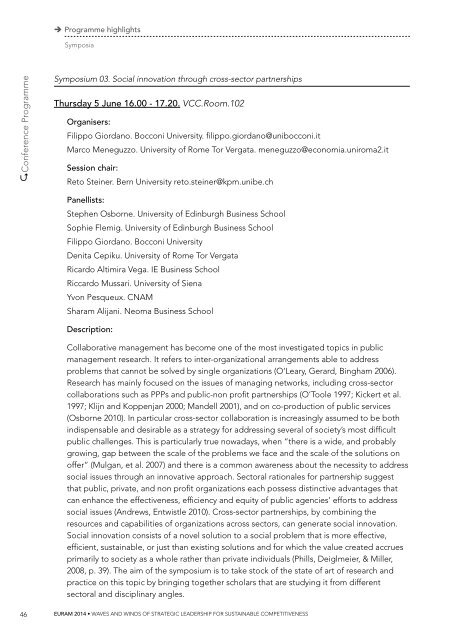euram-libro-baja_20140527141157
euram-libro-baja_20140527141157
euram-libro-baja_20140527141157
Create successful ePaper yourself
Turn your PDF publications into a flip-book with our unique Google optimized e-Paper software.
Î ÎProgramme highlights<br />
Symposia<br />
Conference Programme<br />
Symposium 03. Social innovation through cross-sector partnerships<br />
Thursday 5 June 16.00 - 17.20. VCC.Room.102<br />
Organisers:<br />
Filippo Giordano. Bocconi University. filippo.giordano@unibocconi.it<br />
Marco Meneguzzo. University of Rome Tor Vergata. meneguzzo@economia.uniroma2.it<br />
Session chair:<br />
Reto Steiner. Bern University reto.steiner@kpm.unibe.ch<br />
Panellists:<br />
Stephen Osborne. University of Edinburgh Business School<br />
Sophie Flemig. University of Edinburgh Business School<br />
Filippo Giordano. Bocconi University<br />
Denita Cepiku. University of Rome Tor Vergata<br />
Ricardo Altimira Vega. IE Business School<br />
Riccardo Mussari. University of Siena<br />
Yvon Pesqueux. CNAM<br />
Sharam Alijani. Neoma Business School<br />
Description:<br />
Collaborative management has become one of the most investigated topics in public<br />
management research. It refers to inter-organizational arrangements able to address<br />
problems that cannot be solved by single organizations (O’Leary, Gerard, Bingham 2006).<br />
Research has mainly focused on the issues of managing networks, including cross-sector<br />
collaborations such as PPPs and public-non profit partnerships (O’Toole 1997; Kickert et al.<br />
1997; Klijn and Koppenjan 2000; Mandell 2001), and on co-production of public services<br />
(Osborne 2010). In particular cross-sector collaboration is increasingly assumed to be both<br />
indispensable and desirable as a strategy for addressing several of society’s most difficult<br />
public challenges. This is particularly true nowadays, when “there is a wide, and probably<br />
growing, gap between the scale of the problems we face and the scale of the solutions on<br />
offer” (Mulgan, et al. 2007) and there is a common awareness about the necessity to address<br />
social issues through an innovative approach. Sectoral rationales for partnership suggest<br />
that public, private, and non profit organizations each possess distinctive advantages that<br />
can enhance the effectiveness, efficiency and equity of public agencies’ efforts to address<br />
social issues (Andrews, Entwistle 2010). Cross-sector partnerships, by combining the<br />
resources and capabilities of organizations across sectors, can generate social innovation.<br />
Social innovation consists of a novel solution to a social problem that is more effective,<br />
efficient, sustainable, or just than existing solutions and for which the value created accrues<br />
primarily to society as a whole rather than private individuals (Phills, Deiglmeier, & Miller,<br />
2008, p. 39). The aim of the symposium is to take stock of the state of art of research and<br />
practice on this topic by bringing together scholars that are studying it from different<br />
sectoral and disciplinary angles.<br />
46 EURAM 2014 • WAVES AND WINDS OF STRATEGIC LEADERSHIP FOR SUSTAINABLE COMPETITIVENESS


